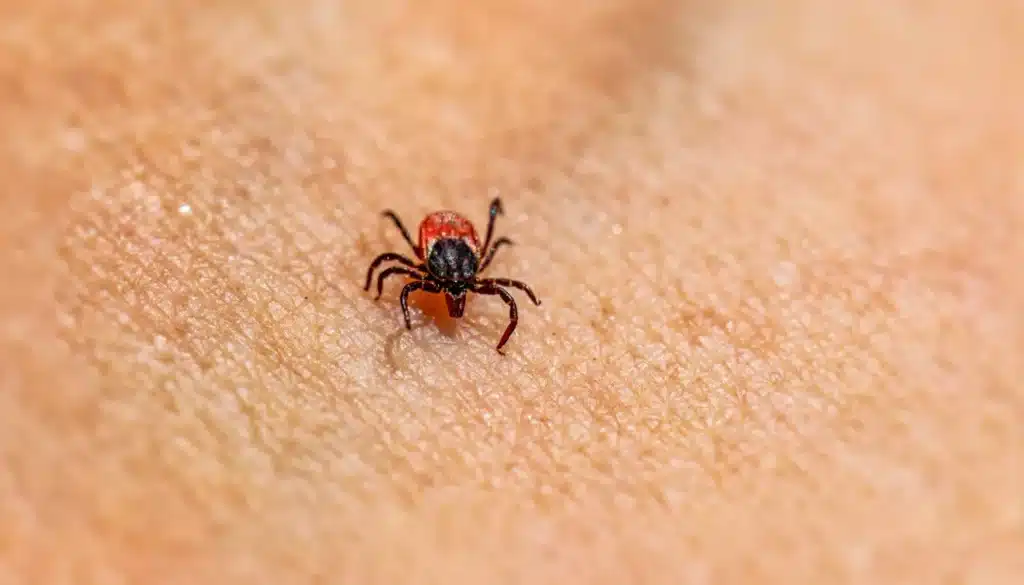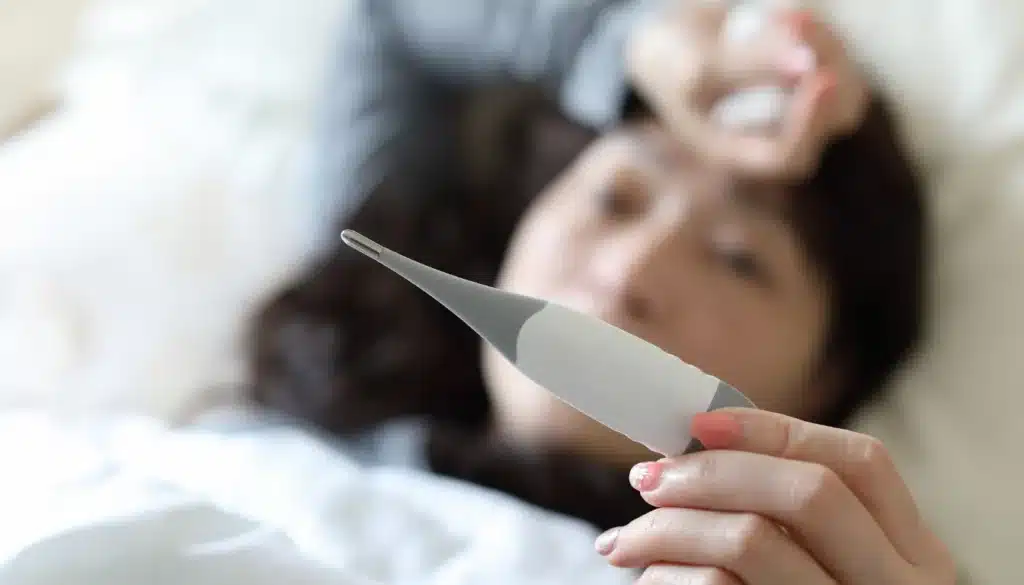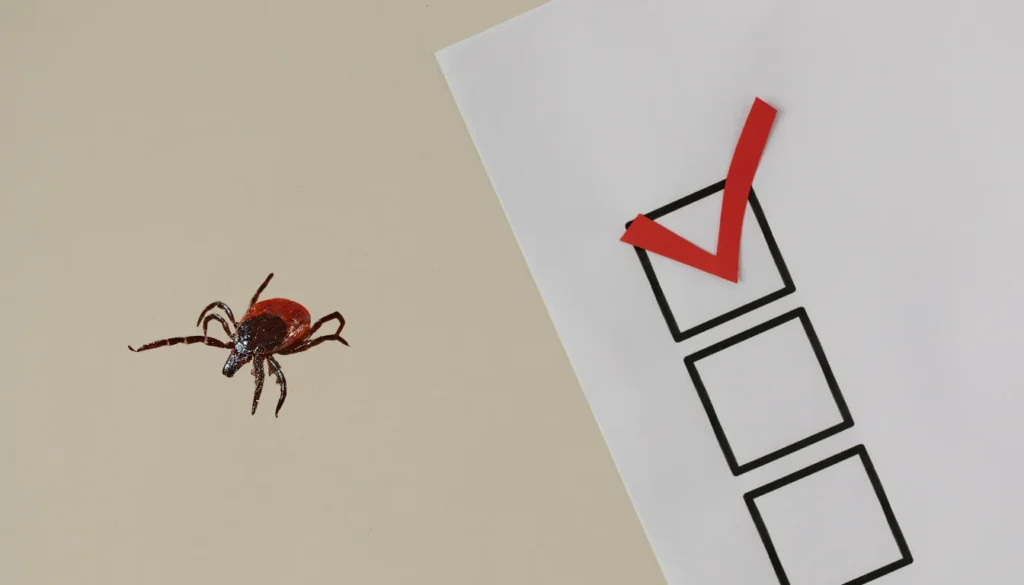Written by Dr. Diane Mueller
You’ve just found a tick attached to your skin. Your heart races as you carefully remove it – but what happens next could make all the difference in preventing Lyme disease. Every year, approximately 476,000 Americans are diagnosed with this debilitating illness. Lyme disease prevention after tick bite within the first 72 hours is crucial. You’re probably wondering if you should rush to the doctor immediately or if there’s something you can do right now to protect yourself. Should you save the tick? What warning signs should you watch for? This guide will walk you through evidence-based prevention strategies that will help prevent health issues caused by a tick bite. You’ll discover when antibiotics might be necessary, which symptoms demand immediate attention, and how to minimize your risk of developing chronic Lyme disease.
Key Takeaways
Proper tick removal is essential: Use fine-tipped tweezers to carefully and promptly remove the tick, avoiding twisting or squeezing to reduce the risk of infection.
Monitor for symptoms after a tick bite: Watch for a bullseye rash, flu-like symptoms, or fatigue, as these may indicate early signs of Lyme disease.
Timing matters for antibiotics: If in a high-risk area or if the tick was attached for over 36 hours, consider taking a single dose of doxycycline within 72 hours to prevent Lyme disease.
Understand your risks with tick exposure: Factors like tick species, duration of attachment, and geographic location influence the likelihood of infection.
Strengthen prevention efforts: Wear permethrin-treated clothing, conduct regular tick checks, and maintain a clean, tick-free outdoor environment to minimize future bites.
Early action is key: Seek medical advice if any symptoms appear or uncertainty about the tick bite arises, as prompt intervention prevents long-term complications.
Table of Contents

Why Post‑Tick Bite Care is Crucial
You’ve just found a tick on your skin. What you do in the next 72 hours could make the difference between a minor inconvenience and months of health struggles. The Borrelia burgdorferi bacteria that causes Lyme disease doesn’t instantly jump from tick to human. It typically takes 36-48 hours of attachment for transmission to occur. That’s your golden window right there.
The 72-Hour Window That Changes Everything
Think of those first three days as your body’s grace period. During this time, the bacteria (if present) hasn’t yet established a foothold in your system. Your immune system still has the upper hand—but only if you act strategically.
Research shows that early intervention can prevent up to 87% of Lyme infections after high-risk tick bites. Those aren’t just numbers; they represent thousands of people who avoided chronic fatigue, joint pain, and neurological symptoms by taking swift action.
Understanding Your Actual Risk Level
It is important to know which ticks carry Lyme disease? Only blacklegged ticks (deer ticks) can carry the bacteria, and infection rates differ by region. In areas like the Northeast, 20-50% of adult ticks may carry Borrelia, whereas in some places, it’s less than 2%. Doctors assess risk based on the tick species, how long it was attached, and your location. For example, a fully engorged tick attached for over 72 hours in Connecticut poses high risk, but a dog tick removed quickly in Arizona is very low risk.
Have Lyme Disease or suspect you do?
Why Proper Removal Makes or Breaks Prevention
Here’s where people mess up: they panic and squeeze the tick’s body, essentially injecting its stomach contents—including any bacteria—directly into their bloodstream. Proper tick removal steps aren’t complicated, but they’re specific.
The Hidden Cascade Effect
Lyme bacteria can quickly spread through your body after a tick bite, reaching places like joints, the nervous system, and the heart where antibiotics may struggle. Early symptoms, such as mild headache or fatigue, can seem insignificant, but the bacteria can cause long-term inflammation. The Lyme disease bullseye rash only appears in 70-80% of cases, so it’s not a reliable warning sign for everyone.
When Prevention Beats Treatment Every Time
Post-exposure prophylaxis involves more than antibiotics, you have to support your body’s natural defense systems while they’re still capable of winning the fight. Your immune resilience, refresh pathways, and microbiome balance all play important roles in whether that tick bite becomes a problem or a non-event.

How the Body Responds After a Tick Bite
Your body’s response to a tick bite may be silent or dramatic. Understanding this biological cascade helps you make smarter decisions during those critical first 72 hours.
Tick bite risk assessment
Not all tick bites are dangerous, and most don’t result in Lyme disease. Knowing a the difference between a normal tick bite versus Lyme depends on three main factors:
Geographic location: Areas like Connecticut and Wisconsin have a high percentage (20-50%) of infected blacklegged ticks, while southern regions like South Carolina have much lower infection rates (1-2%).
Tick species: Only blacklegged ticks (deer ticks) and western blacklegged ticks can transmit Lyme in North America. Other ticks, like dog ticks, can’t spread Lyme disease.
- Here’s the factor that trumps everything else: attachment duration.
Risk Factor | Low Risk | Moderate Risk | High Risk |
|---|---|---|---|
Time Attached | <24 hours | 24-36 hours | >36 hours |
Tick Appearance | Flat, unfed | Partially engorged | Balloon-like, fully engorged |
Geographic Area | Non-endemic | Transitional zones | Endemic regions |
Tick Species | Dog/wood tick | Unknown species | Confirmed blacklegged |
The magic number everyone obsesses over—36 hours—isn’t arbitrary. Borrelia bacteria live in the tick’s gut and need time to migrate to salivary glands before transmission occurs.
What happens if Borrelia enters
When Lyme-causing bacteria enter your body, your immune system fights back, but responses differ between people. Symptoms can take 3-30 days to show, often around days 7-14. The common bullseye rash appears in about 70% of cases, but 30% never get a rash. Even when present, rashes may vary in shape or appear in different areas, leading to missed diagnoses.
The bacteria can change form to dodge the immune system, hiding in tissues, and even going dormant. Symptoms may include fever, joint pain, fatigue, or even sudden issues weeks later, like swollen knees. To make it more challenging, early blood tests often fail to detect infections, delaying diagnosis and treatment.
Have Lyme Disease or suspect you do?
Proper Tick Removal Steps
You’ve found a tick attached to your skin—now what? The way you remove that tick can make the difference between a simple bite and potentially pushing harmful bacteria deeper into your bloodstream.
What’s crucial: tick removal
Start with fine‑tipped tweezers. Grab a pair of fine-tipped tweezers (not kitchen tongs or your fingers!) and position them as close to the tick’s mouthparts as possible, right where it’s attached to your skin. This ensures you’re targeting the tick, not just its body.
Pull it straight upward—no twisting! With steady, even pressure, pull straight up. Resist the urge to twist or wiggle! Twisting can cause the tick’s head or mouthparts to break off, which you don’t want left behind.
Clean the bite area. Once the tick is out, it’s time to wash up! Wash the bite site and your hands thoroughly with soap and warm water or disinfect with rubbing alcohol.
Save the tick in a sealed bah. Place the tick in a sealed plastic bag to show your doctor for identification.
Log key details. Jot down the date, time, and location of the bite while it’s fresh in your mind. This information will be helpful for your doctor if needed later.
Common mistakes people don’t see
Do not use harmful methods like applying heat, nail polish, petroleum jelly, or essential oils to remove ticks—it can make the tick release bacteria into your bloodstream. Check your body thoroughly, especially in hidden areas like the hairline, behind ears, armpits, groin, behind knees, and between toes, as ticks prefer these spots. Nymphs, which are hardest to spot, pose the highest Lyme disease risk.
If you make mistakes during removal, such as squeezing the tick or leaving its head embedded, monitor the site for infection signs or a bullseye rash. Follow proper removal steps and watch for symptoms. If in a high-risk area, consult a Lyme disease expert for guidance.

When to Use Antibiotics: Prophylaxis Guidelines
You’ve removed the tick properly and now you’re wondering if you need antibiotics. Here’s the thing—not every tick bite requires medication, but there’s a specific window where a single dose can slash your risk of developing Lyme disease.
CDC / IDSA Criteria for doxycycline prophylaxis
The decision to take preventive antibiotics isn’t a guessing game. Both the CDC and Infectious Diseases Society of America have crystal-clear criteria that ALL need to be met:
Act within 72 hours: Start preventive treatment within 72 hours of removing the tick, or it won’t work.
Tick type matters: Only deer ticks (Ixodes) need Lyme prevention. Other tick types don’t transmit Lyme but may carry other diseases.
Geography is key: Prophylaxis is only necessary in high-risk areas, like the Northeast U.S. Check CDC maps for guidance.
Attachment duration counts: The tick must be attached for at least 36 hours to pose a risk. An engorged tick suggests longer attachment.
Health considerations. If you’re 8 years or older, not pregnant, and don’t have allergies to antibiotics, doxycycline should be safe to use.
Doxycycline for tick bite prophylaxis: dosage & timing
Adult dosage. One 200 mg oral dose can work wonders (and yes, you only take it once).
For kids. The dosage is 4.4 mg per kilogram, up to 200 mg total. But this is only recommended for children 8 years or older.
Effectiveness stats. Research shows that a single dose reduces the chance of developing erythema migrans (the bullseye rash) by about 71%. For every 50 people treated, one case of Lyme disease is prevented—pretty good odds!
Limitations & controversies
While it may feel like a no-brainer, using doxycycline for tick bite Lyme prevention isn’t without its questions. Here’s what you should know:
Evidence isn’t perfect. The major studies focus on preventing the bullseye rash, but they don’t fully measure long-term impacts. Some experts argue that this creates a bit of a gray area.
Shared decision-making is key. Weighing the pros and cons with your doctor is important. For some, the peace of mind from taking antibiotics outweighs any uncertainties. For others, monitoring symptoms might be enough.
Longer courses? Not for prevention. Extended antibiotics are reserved for treating active infections—not as a precaution. Standard treatment for Lyme disease usually lasts 7–14 days and only begins if there’s confirmed infection.
Have Lyme Disease or suspect you do?
Beyond Antibiotics: Functional Prevention Strategies
While antibiotics have their place in post-tick bite prevention, your body’s natural defenses deserve equal attention. Functional medicine approaches can amplify your immune system’s ability to fight off potential infections before they take hold.
Boosting immune resilience
After a tick bite, support your immune system quickly. Within 24 hours, boost it with nutrients:
Vitamin C: Take 1,000-2,000mg daily for two weeks to strengthen white blood cells against Lyme bacteria.
Vitamin D3: Add 2,000-4,000 IU daily for better outcomes against tick-borne pathogens.
Zinc: Take 15-30mg daily to block bacteria, but always with food to avoid nausea.
Adaptogens: Use 500mg of astragalus root extract twice daily for one month to help immune cells react properly.
If on doxycycline, include a high-quality probiotic with at least 50 billion CFUs (e.g., Lactobacillus rhamnosus, Saccharomyces boulardii) to protect your gut, but take it 2-3 hours apart from antibiotics.
Detoxification & Lyme pathogen clearance
Support your body’s recovery after a tick bite by aiding your liver, which processes bacteria and toxins. Use milk thistle extract (200-400mg daily) to protect liver cells, and take NAC (600mg twice daily) to boost glutathione, an antioxidant that neutralizes toxins.
For extended antibiotic use, add gentle binders like activated charcoal (500mg, taken 2 hours away from other meds) or chlorella to remove bacterial debris and reduce inflammation. Modified citrus pectin (start with 5g daily in water) can also help eliminate toxins and heavy metals. Stay hydrated by drinking half your weight in ounces of filtered water daily, adding a pinch of Celtic sea salt to every other glass for minerals.
Lifestyle & environmental prevention
Use wood chip barriers (3 feet wide) between wooded areas and your lawn to stop ticks from migrating.
Keep grass short (under 3 inches) to reduce tick survival; clear leaf litter monthly to remove their hiding spots.
Avoid Japanese barberry bushes; replace them with native plants to reduce tick-friendly environments.
Treat clothing with permethrin, wear light-colored pants tucked into socks, and dry clothes on high heat after outdoor activities.
Do daily tick checks, especially in hard-to-see areas, and check pets regularly.
Keep a tick kit with tweezers, rubbing alcohol, containers, and a marker ready for quick response.
Use outdoor showers for a quick rinse after high-risk outdoor activities to wash away unattached ticks.

Decision Flowchart Table
If you’re uncertain if it’s a Lyme disease tick bite or not, here’s a clear path to follow. Start by checking how well the bite matches the CDC’s “high-risk” criteria—like a checklist—to determine if preventive antibiotics are needed.
Criterion | Action |
|---|---|
High‑risk bite meets all CDC criteria | Offer single‑dose doxycycline prophylaxis |
Contraindicated doxycycline or risk unclear | Watch and wait + monitor symptoms and rash |
Symptoms or rash develop | Full antibiotic treatment course (7‑14 days) |
No symptoms after 30 days | No action needed; reinforce preventive strategies |
- The CDC recommends antibiotic prophylaxis for Lyme disease only if all four conditions are met: an Ixodes tick attached for over 36 hours, removed within 72 hours, located in a high-risk area, and no contraindications to doxycycline.
- If any condition is missing, you’ll monitor symptoms instead of taking antibiotics. Watching for symptoms isn’t passive—track unusual fatigue, headaches, or joint tingling. Risk depends on geography, tick species (blacklegged ticks are key), and attachment duration, as these factors greatly affect your chances of Lyme disease.
- If symptoms like a bullseye rash or flu-like feelings occur, start treatment with antibiotics immediately, even before test results. Early treatment is key. Some doctors go beyond guidelines, suggesting immune-boosting measures like vitamin C and zinc while you monitor symptoms.
- If no symptoms appear by 30 days, you’re likely clear of Lyme, but staying alert for late-onset signs is wise. Afterward, focus on prevention, like maintaining protective clothing or yard care. Gray areas, like uncertain tick attachment times or traveling through endemic zones, require tailored medical advice rather than strict guidelines.
Conclusion: Summary Action Pathways
You’ve got the knowledge and tools to protect yourself after a tick bite. The path forward depends on your specific situation but always starts with swift action and careful observation. Your best defense combines quick tick removal with strategic monitoring over the next 30 days.
Remember prevention extends beyond the immediate response. Creating tick-safe environments and establishing regular body checks will serve you well during future outdoor adventures. Your proactive approach today can prevent complications tomorrow.
Most tick bites won’t lead to Lyme disease but staying vigilant ensures you’ll catch any warning signs early. Trust your instincts about your body’s signals and don’t hesitate to seek medical attention if something feels off.
You’re not just protecting yourself from one tick bite – you’re building a lifetime strategy for outdoor safety and health awareness.
Have Lyme Disease or suspect you do?
Frequently Asked Questions
In most cases, a blacklegged (Ixodes) tick needs to be attached for 36 to 48 hours for Borrelia burgdorferi transmission to occur. If removed within 24 hours, risk is very low. Prompt removal greatly reduces infection likelihood.
Clean the site with soap and water or rubbing alcohol. Keep the tick in a sealed bag for identification if needed.
Prophylaxis is advised only if all these are true: the tick is a blacklegged (Ixodes) tick, it’s been attached ≥36 hours, the bite occurred in a high-incidence area, and doxycycline is safe for the patient. It must be given within 72 hours of removal.
A single dose of doxycycline—200 mg for adults or 4.4 mg/kg (max 200 mg) in children—is recommended within 72 hours after removal of a qualifying tick. Guidelines support one-time dosing even in children ≥8 years old in high-risk scenarios.
Symptoms typically appear 3 to 30 days after a bite and may include the erythema migrans rash (often non–bullseye), fatigue, fever, headache, muscle or joint aches, and swollen lymph nodes. Even without a rash, flu‑like symptoms merit medical attention.
Yes. There is currently no human immunity to Lyme disease, meaning it’s possible to get it again after prior infection. Preventing future tick bites is key, even if you’ve had Lyme before
Use EPA-registered repellents (DEET, picaridin, lemon eucalyptus) on exposed skin, treat clothing or gear with permethrin, wear light-colored, long clothing, tuck shirt into pants and pants into socks, stay on trails, and do daily tick checks, especially on hard-to-see areas.
Note the date and location of the bite, photograph any rash, and start a 30-day symptom journal. Recording this helps your healthcare provider accurately assess your risk and decide if treatment is needed.
Yes. Other tick-borne pathogens like anaplasmosis, babesiosis, or Powassan virus may be transmitted in the same bite. These infections can cause similar flu-like symptoms and may require different treatment—consider medical evaluation if symptoms evolve.
References
- Kugeler, K. J., Schwartz, A. M., Delorey, M., et al. Estimating the frequency of Lyme disease diagnoses — United States, 2010–2018. Emerging Infectious Diseases, 2021;27(2). https://wwwnc.cdc.gov/eid/article/27/2/20-2259_article
- Schwartz, A. M., Kugeler, K. J., Nelson, C. A., et al. Use of Commercial Claims Data for Evaluating Trends in Lyme Disease Diagnoses, United States, 2010-2018. Emerging Infectious Diseases, 2021;27(2). https://wwwnc.cdc.gov/eid/article/27/2/20-2260_article
- Nadelman, R. B., Nowakowski, J., Fish, D., et al. Prophylaxis with single-dose doxycycline for the prevention of Lyme disease after an Ixodes scapularis tick bite. New England Journal of Medicine, 2001;345(2):79-84. https://www.nejm.org/doi/full/10.1056/NEJM200107123450201
Price, L., Winter, A. M., Savage, J., et al. In the Northeast, 50% of Adult Ticks Carry Lyme Disease. Department of Geography, Dartmouth College, 2025. https://geography.dartmouth.edu/news/2025/01/northeast-50-adult-ticks-carry-lyme-disease
Diuk-Wasser, M. A., Hoen, A. G., Cislo, P., et al. Human risk of infection with Borrelia burgdorferi, the Lyme disease agent, in eastern United States. American Journal of Tropical Medicine and Hygiene, 2012;86(2):320-327. https://www.ncbi.nlm.nih.gov/pmc/articles/PMC3269278/
Steere, A. C., Strle, F., Wormser, G. P., et al. Lyme borreliosis. Nature Reviews Disease Primers, 2016;2:16090. https://www.nature.com/articles/nrdp201690
- Centers for Disease Control and Prevention. Signs and symptoms of untreated Lyme disease. CDC.gov, 2021. https://www.cdc.gov/lyme/signs_symptoms/index.html
Wormser, G. P., Dattwyler, R. J., Shapiro, E. D., et al. The clinical assessment, treatment, and prevention of Lyme disease, human granulocytic anaplasmosis, and babesiosis: Clinical practice guidelines by the Infectious Diseases Society of America. Clinical Infectious Diseases, 2006;43(9):1089-1134. https://academic.oup.com/cid/article/43/9/1089/436629
Centers for Disease Control and Prevention. Lyme disease: Tick removal and testing. CDC.gov, 2022. https://www.cdc.gov/lyme/removal/index.html
Free Lyme/Mold Webinar: "Why Am I Still Sick?"
Have Lyme Disease or suspect that you do?
We have helped thousands of
people restore their health
and quality of life by diagnosing
and treating their Lyme Disease.
“Dr. Mueller’s approach to medicine is refreshing! There is only so much you can do with western medicine and in my life I was needing a new approach. By addressing the whole body, nutritional diet factors, environmental factors, blood work, and incorporating ideas I had not previously known, I was able to break through with my conditions. I am not only experiencing less pain in my life, but through the process of healing guided by Dr. Diane Mueller, I am now happy to say I have more consciousness surrounding how I eat, what to eat and when things are appropriate. Living by example Dr. Mueller has a vibrancy that makes you want to learn and know more about your body and overall health. I highly recommend her to anyone looking for new answers, a new approach to health, or in need of freedom from pain and limitations.”
-Storie S.
Kihei, HI


